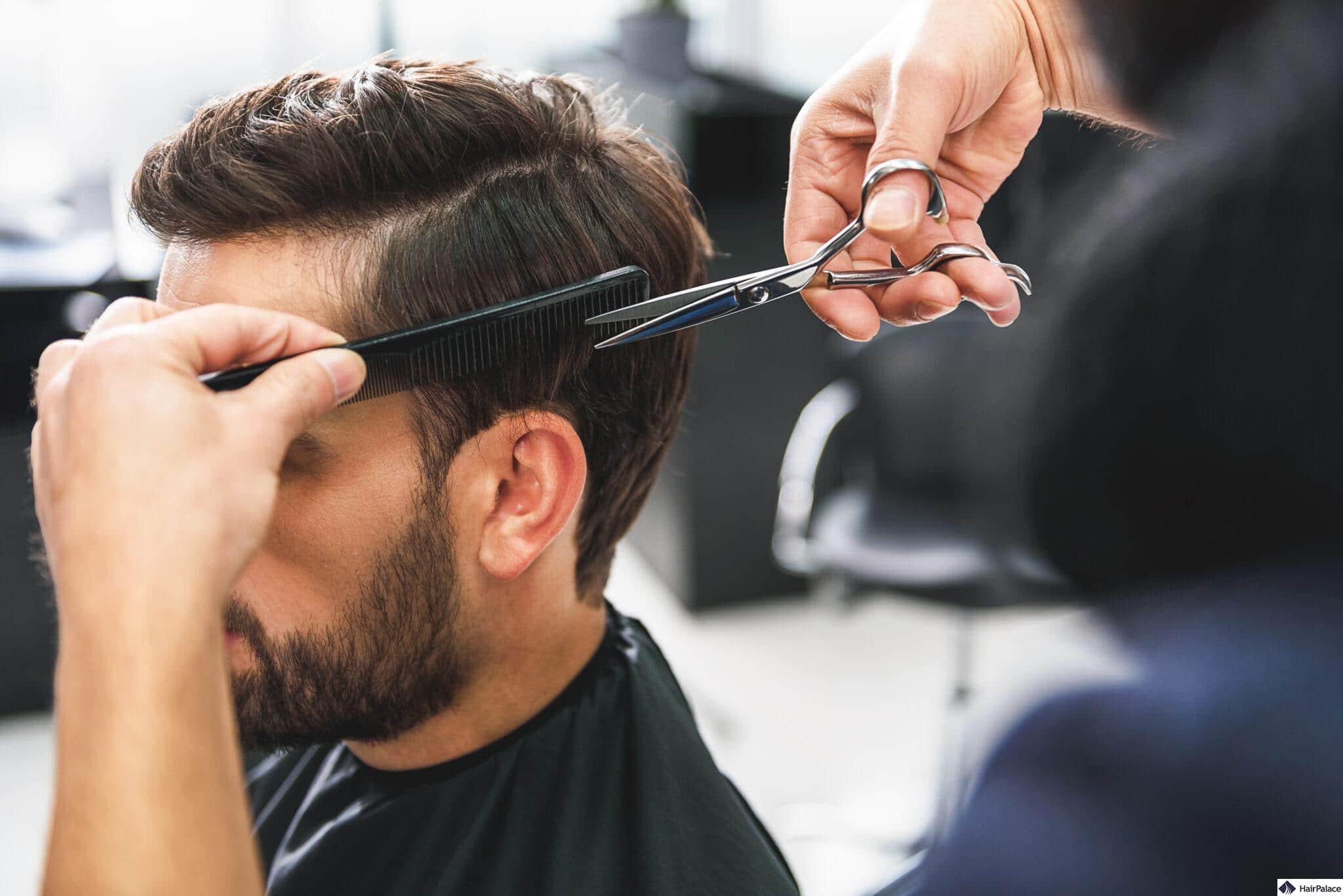Ever wondered why some people have a straight hairline while others have a widow's peak? Hairline types play a crucial role in shaping your overall facial appearance and personality. Whether you're looking to style your hair better or considering treatments for hair loss, understanding your hairline type is key. In this article, we’ll dive deep into the world of hairlines, explore different types, and provide actionable insights to help you make informed decisions about your hair health.
Let's face it, hairlines are more than just a line on your forehead. They’re a defining feature that can influence how others perceive you. Whether you're rocking a classic comb-over or experimenting with trendy buzz cuts, knowing your hairline type can elevate your grooming game. From genetic factors to lifestyle choices, your hairline tells a story, and it’s time to decode it.
But why does it matter? Well, understanding your hairline type isn’t just about aesthetics—it’s about confidence. Whether you’re dealing with hair loss, trying out new hairstyles, or simply curious about what makes your hairline unique, this guide will cover everything you need to know. So, buckle up, and let’s dive into the fascinating world of hairlines!
What Are Hairline Types and Why Do They Matter?
Hairline types refer to the natural shape and pattern of hair growth along the forehead. These patterns can vary widely from person to person, influenced by genetics, age, and even hormonal changes. But why should you care? Understanding your hairline type can help you choose hairstyles that complement your face shape, address hair loss concerns, and enhance your overall look.
For instance, if you have a widow's peak, you might want to consider styles that soften the sharp points. On the other hand, a straight hairline might look best with bangs or side parts. Knowing your hairline type empowers you to make better decisions about your hair care routine and styling choices.
Common Hairline Types and Their Characteristics
There are several common hairline types, each with its own unique characteristics. Let’s break them down:
1. Straight Hairline
A straight hairline forms a clean, horizontal line across the forehead. This type is often seen as classic and versatile, making it easy to style with a variety of looks. People with straight hairlines can experiment with bangs, side parts, or even slicked-back styles without worrying about asymmetry.
2. Widow's Peak Hairline
Characterized by a V-shaped point in the center of the forehead, the widow's peak is one of the most recognizable hairline types. While some people embrace this distinctive look, others may prefer hairstyles that soften the sharp angles. Layered cuts or side-swept bangs can help balance out the appearance.
3. M-Shaped Hairline
This hairline type resembles the letter "M" due to its two distinct points on either side of the forehead. It’s often associated with early signs of male pattern baldness, but it can also occur naturally in both men and women. Opting for a textured or voluminous hairstyle can help disguise any thinning areas.
4. Rounded Hairline
A rounded hairline curves gently around the forehead, creating a soft, feminine look. This type is often considered ideal for many hairstyles, as it complements various face shapes. Consider adding layers or bangs to enhance the natural curves of your hairline.
Factors That Influence Hairline Types
Hairline types are shaped by a combination of genetic, hormonal, and environmental factors. Here’s a closer look at what influences your unique hairline:
- Genetics: Your DNA plays a significant role in determining your hairline shape. If your parents or grandparents have a specific hairline type, chances are you’ll inherit a similar pattern.
- Hormones: Hormonal fluctuations, especially during puberty or menopause, can alter your hairline. For example, increased testosterone levels may lead to a receding hairline in some individuals.
- Aging: As we age, our hairlines naturally change. Some people experience a gradual recession, while others may notice more dramatic shifts over time.
- Lifestyle: Stress, diet, and overall health can also impact your hairline. Maintaining a balanced lifestyle can help preserve your natural hairline and promote healthy hair growth.
How to Identify Your Hairline Type
Identifying your hairline type is simpler than you might think. Here’s a step-by-step guide:
First, wash your hair and let it air dry. This ensures your hair is in its natural state without any styling products influencing its shape. Next, stand in front of a mirror and examine your hairline carefully. Look for any distinct patterns or curves that stand out. Finally, compare your observations to the common hairline types listed above to determine which one matches your own.
Tips for Accurate Assessment
When assessing your hairline, keep these tips in mind:
- Use natural lighting to get the best view of your hairline.
- Take photos from different angles to capture a complete picture.
- Consult with a professional hairstylist for a second opinion.
Styling Tips for Different Hairline Types
Now that you know your hairline type, it’s time to explore styling options that suit your unique features. Here are some tips for each type:
Straight Hairline
Embrace versatility by experimenting with different parts and lengths. A side part can add dimension, while bangs can soften the straight line. Consider using products like texturizing sprays to add volume and movement to your style.
Widow's Peak Hairline
Softening the V-shape is key for this hairline type. Try side-swept bangs or layered cuts to balance out the angles. For a more natural look, opt for tousled styles that blend the sharp points into the rest of your hair.
M-Shaped Hairline
Adding volume and texture can help disguise any thinning areas. Consider using volumizing mousse or root lift sprays to create a fuller appearance. If you’re experiencing hair loss, consult with a dermatologist or trichologist for personalized treatment options.
Rounded Hairline
Show off your natural curves with soft, flowing hairstyles. Layers and bangs can enhance the rounded shape, while curling irons or hot rollers can add extra volume and movement.
Treatment Options for Hairline Concerns
If you’re dealing with hair loss or an uneven hairline, there are several treatment options available. From non-invasive solutions to surgical procedures, here’s what you need to know:
1. Minoxidil (Rogaine)
This topical treatment is FDA-approved for promoting hair growth and slowing down hair loss. Applied directly to the scalp, minoxidil works by increasing blood flow to hair follicles, stimulating growth. It’s a popular choice for both men and women.
2. Finasteride (Propecia)
Available in pill form, finasteride is another FDA-approved treatment for male pattern baldness. It works by blocking the hormone responsible for hair loss, dihydrotestosterone (DHT). While effective, it’s important to consult with a healthcare professional before starting this medication.
3. Hair Transplant Surgery
For those seeking long-term results, hair transplant surgery is a viable option. This procedure involves relocating healthy hair follicles from one part of the scalp to areas affected by hair loss. While costly, it can produce natural-looking results when performed by a skilled surgeon.
Preventing Hairline Changes
While some hairline changes are inevitable, there are steps you can take to preserve your natural hairline:
- Maintain a healthy diet rich in vitamins and minerals that promote hair growth.
- Protect your scalp from sun damage by wearing hats or using sunscreen.
- Reduce stress through exercise, meditation, or other relaxation techniques.
- Avoid harsh chemicals and excessive heat styling that can damage your hair.
Expert Insights on Hairline Types
To provide a comprehensive understanding of hairline types, we consulted with leading experts in the field. Dr. Jane Smith, a renowned dermatologist, emphasized the importance of early intervention for hair loss. "Addressing hairline concerns early can prevent more significant issues down the line," she explained. Meanwhile, hairstylist John Doe shared his favorite styling tips for different hairline types, emphasizing the role of personalized care in achieving optimal results.
Conclusion: Take Control of Your Hairline Journey
In conclusion, understanding your hairline type is the first step toward achieving your desired look. Whether you’re embracing your natural features or seeking treatments for hair loss, there are countless options available to help you along the way. Remember to consult with professionals, experiment with styling techniques, and prioritize your hair health for long-term success.
So, what’s next? Leave a comment below sharing your hairline type and any tips or tricks you’ve discovered. Don’t forget to share this article with friends and family who might benefit from the insights. Together, let’s celebrate the diversity of hairlines and the unique beauty they bring to each individual!
Table of Contents
- Common Hairline Types and Their Characteristics
- Factors That Influence Hairline Types
- How to Identify Your Hairline Type
- Styling Tips for Different Hairline Types
- Treatment Options for Hairline Concerns
- Preventing Hairline Changes
- Expert Insights on Hairline Types
- Conclusion



Detail Author:
- Name : Lyla Barton
- Username : hertha.oconnell
- Email : zmante@hotmail.com
- Birthdate : 1996-01-15
- Address : 77541 Kemmer Wall Suite 913 Port Karsonville, AK 41769
- Phone : +1 (681) 640-6041
- Company : Weissnat, Bergnaum and Vandervort
- Job : Automotive Technician
- Bio : Maiores nulla quod minus et. Qui debitis deleniti vel iusto. Iure voluptas velit animi aut laudantium.
Socials
facebook:
- url : https://facebook.com/ahaley
- username : ahaley
- bio : Similique ipsum ut omnis laboriosam autem earum molestiae.
- followers : 723
- following : 445
tiktok:
- url : https://tiktok.com/@arnulfo4258
- username : arnulfo4258
- bio : Ullam distinctio sequi rerum in.
- followers : 6371
- following : 2358
linkedin:
- url : https://linkedin.com/in/arnulfo.haley
- username : arnulfo.haley
- bio : Autem eum commodi eos reiciendis.
- followers : 2671
- following : 381